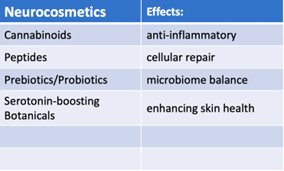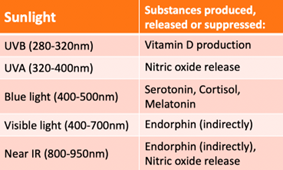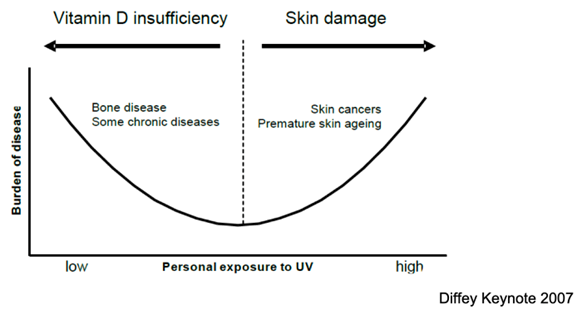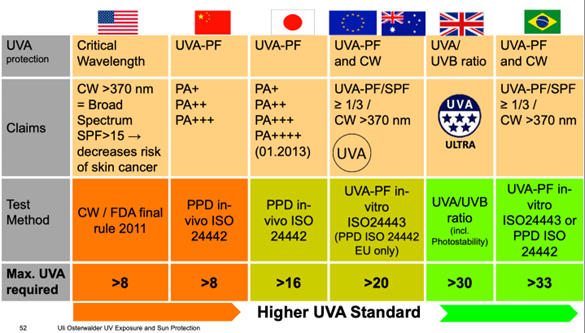Sunlight has a stronger neuro-effect than any of the active ingredient in cosmetics. How can we best tame this freely available, most potent neuro-cosmetic? The answer is: with sunscreen.
1. Neurocosmetics Trends, Actives and Effects
Neuro cosmetics cater to the growing demand for products that not only improve skin appearance but also enhance overall well-being by targeting the emotional and neurological factors that can impact skin health. The Financial Times recently asked: Can a cream make your skin happy? and subtitled: The beauty industry wants to get inside your head [1].
Current Trends in Neuro Cosmetics comprise:
Personalized Skincare: Many brands are adopting AI and machine learning to create customized neuro cosmetic products based on individual skin needs and stress levels.
Sustainable, Plant-Based Ingredients: Many neuro cosmetic products use sustainably sourced, plant-based ingredients that align with broader trends in clean beauty.
Multi-Functional Products: Consumers are looking for products that combine skincare benefits with mood-enhancing effects, resulting in an increase in neuro cosmetics that are marketed as “self-care” tools.
Tech and Skin Monitoring: With wearables and apps, some neuro cosmetic brands are focusing on biofeedback. They monitor stress and skin response to give personalized advice or suggest products tailored to one’s neurophysiological state.
Clinical Research and Credibility: Neuro cosmetics brands are working with neuroscientists and dermatologists to validate the efficacy of their products, as consumers are increasingly looking for evidence-based claims in beauty.
A web search conducted by ChatGPT [2] reveals the following ingredients in Neuro Cosmetics:
Cannabinoids (CBD): Known for its calming and anti-inflammatory properties, CBD is a popular neuro cosmetic ingredient.
Adaptogens: Natural substances like ashwagandha, ginseng, and reishi mushroom that help the skin manage stress, commonly included to reduce the visible effects of stress on the skin.
Peptides: Specific neuropeptides are added to reduce wrinkles and fine lines, as they communicate with the skin’s cells to boost collagen production and cellular repair.
Prebiotics and Probiotics: These help balance the skin’s microbiome, promoting a healthier skin barrier and reducing sensitivity.
Serotonin-Boosting Botanicals: Certain botanicals, like saffron and rose, are said to boost serotonin levels, creating a positive effect on mood while enhancing skin health.
In Table 1 examples of neuro-cosmetics are compared with substances produced, released or suppressed by sunlight. This illustrates how potent the various effects of sunlight are.


Table 1 Examples of Neuro-cosmetic effects and substances produced, released or suppressed by sunlight (effects described in text)
2. Effects of Sunlight
Now let’s compare these Neuro effects with the effects of sunlight, neuro and beyond. The Web search, again with the help of ChatGPT [2], reveals 6 major positive effects (I-VI). The positive effect of sunlight on the cardiovascular system and thus lower all-cause morbidity did not show up in this search (effect group VII below, work of Prof. RB Weller et al).
Mood Enhancement
Serotonin Boost: Exposure to sunlight increases the release of serotonin, a neurotransmitter associated with improved mood and feelings of well-being. Higher serotonin levels can lead to a brighter mood, reduced anxiety, and less likelihood of experiencing depression.
Vitamin D Production: Sunlight is essential for synthesizing vitamin D in the skin, which is linked to mood regulation and brain health. Low levels of vitamin D are associated with mood disorders, including seasonal affective disorder (SAD).
Circadian Rhythm Regulation
Melatonin Suppression: Exposure to morning sunlight helps regulate the body’s circadian rhythm by suppressing melatonin production during the day. This suppression helps maintain a clear sleep-wake cycle, signaling wakefulness during the day and sleepiness at night.
Sleep Quality: Regular exposure to natural light, especially early in the day, promotes better sleep by ensuring that melatonin production ramps up in the evening, facilitating restful and high-quality sleep.
Energy Levels and Alertness
Cortisol Release: Exposure to sunlight triggers the release of cortisol, a hormone that enhances alertness and energy. Natural sunlight, especially in the morning, can boost cognitive function and increase energy levels throughout the day.
Reduced Fatigue: Natural light exposure helps mitigate feelings of fatigue by encouraging wakefulness and increasing blood flow to the brain, which helps with focus and mental clarity.
Neuroprotective Effects
Enhanced Neurotransmitter Function: Sunlight aids in the production of key neurotransmitters, like dopamine and serotonin, which are critical for memory, learning, and emotional regulation.
Reduced Inflammation: Sunlight exposure in moderation has been shown to have anti-inflammatory effects, which can benefit brain health and may protect against neurodegenerative conditions.
Mental Health and Reduced Stress
Endorphin Release: Sunlight stimulates the release of endorphins, the body’s natural “feel-good” hormones. These endorphins can help reduce stress levels, combat depressive symptoms, and elevate overall well-being.
Stress Regulation: By helping balance the body’s production of cortisol and other stress-related hormones, sunlight can help manage stress and reduce the harmful effects of chronic stress on the brain and body.
Cognitive Function
Improved Focus and Memory: Regular exposure to natural light, especially in the morning, has been shown to improve cognitive performance, including memory and focus, likely due to the impact on neurotransmitter activity and circadian alignment.
Potential Reduction in Cognitive Decline: Long-term, regular sunlight exposure has been associated with a lower risk of cognitive decline in aging populations, possibly due to its neuroprotective effects.
Lower Mortality
A recent study comes to the conclusion that “Higher ultraviolet light exposure is associated with lower mortality “ [3]. The UV exposures were inversely associated with all-cause, cardiovascular disease (CVD) and cancer mortality. The benefits of UV exposure may outweigh the risks in low-sunlight countries.
Growing evidence shows that sunlight has health benefits through vitamine D independent pathways, such as photomobilization of nitric oxide from cutaneous stores with reduction in cardiovascular morbidity. Sunlight has important systemic health benefit as well as risks [4-6]

Figure 1 Risk and Benefit of UV radiation. Vitamin D is only one of many benefits (see table 1)
3. Risk and Benefits of Sunlight
Figure 1 illustrates that risk and benefit of sunlight depends on the personal exposure. There is an optimum overall personal exposure, but there is also a specific optimum for certain parts of the skin, e.g. it may be wise to protect the facial skin to avoid hyperpigmentation in this area which is most visible.
The risks of sunlight, in particular the UV radiation part (UVR) is well known. Skin cancer, photo-aging, and induction or exacerbation of photosensitive dermatoses have been the focus of most photobiological research since 1928 when Findlay confirmed the carcinogenicity of ultraviolet radiation using a murine model of skin cancer. The epidemiological, mechanistic and clinical trial data have enabled the classification by the International Agency for Research on Cancer of ultraviolet radiation as a Group 1 (‘sufficient evidence’) carcinogen for human skin.
Public health advice in most developed countries with a pale-skinned population following this has advocated limiting exposure to sunlight through use of clothing, sunblock and behavioral alterations. Despite this plethora of data, one striking omission is evidence that ultraviolet radiation shortens life. Epidemiological and mechanistic data suggest that also UVR may have significant benefits on health and in particular cardiovascular health.
The on-going discussion about Neurocosmetics is an opportunity to emphasize also the benefits. Epidemiological studies from the United Kingdom and Sweden link sun exposure with reduced all-cause, cardiovascular, and cancer mortality. Vitamin D synthesis is dependent on UVB exposure. Individuals with higher serum levels of vitamin D are healthier in many ways, yet multiple trials of oral vitamin D supplementation show little benefit. Growing evidence shows that sunlight has health benefits through vitamin D-independent pathways, such as photomobilization of nitric oxide from cutaneous stores with reduction in cardiovascular morbidity. Sunlight has important systemic health benefit as well as risks.
4. Balanced Sun Protection Required
Using the sun as source for potent neuro effects bears the risk of contracting skin damage, short- and long-term. To mitigate this risk, wearing sunscreen is recommended. The other major sun protection measures such as avoiding the sun and covering up, do obviously not serve the purpose of getting the desired “neuro-effects” from the sun. The next question is what type of protection is recommended from the sunscreen. As the potential damage comes mainly from UVR, spectral homeostasis protection is the best option, i.e. uniform protection throughout the UV range, UVB as well as UVA [7-10].
Historically, sunscreens have protected mainly against UVB radiation; with only UVB filters a maximum of SPF 12-15 were achievable, but over the years, with the inventions of UVA- and broad-spectrum UV filters, sunscreens provided more and more UVA protection. This led also to higher expectations as depicted in the evolution of UVA requirements in Table 2. However, there is no global harmonization of UVA protection levels yet.

Table 2 Evolution of Norms and global standards of the UVA-Protection Factor
CONCLUSION
Neuro Cosmetics can help us appreciate more the positive neuro effects of natural sunlight, and artificial sunlight for that matter. However, to use the sun, this free source of positive neuro-effects, we have to be aware of the risks of sun exposure and (intentional) sunbathing, especially the damaging effects of too much UVR exposure. That is where sunscreens play a role. Ideally, they reduce the quantity of all UV exposure, but do not change the quality of the natural sun spectrum, aka spectral homeostasis protection.
References
Cavanagh A, Can a cream make your skin happy? The beauty industry wants to get inside your head, Financial Times, MARCH 19 2024, https://www.ft.com/content/5d3314f5-574d-4105-b201-7e9d9979aa22 accessed 2024-11-08
OpenAI. ChatGPT, November 10 version, OpenAI, 2024, https://chat.openai.com.
Stevenson AC, Clemens T, Pairo-Castineira E, Webb DJ, Weller RB, Dibben C. Higher ultraviolet light exposure is associated with lower mortality: An analysis of data from the UK biobank cohort study. Health Place. 2024 Sep;89:103328. doi: 10.1016/j.healthplace.2024.103328. Epub 2024 Aug 1.
Weller RB. Sunlight: Time for a Rethink? J Invest Dermatol. 2024 Aug;144(8):1724-1732. doi: 10.1016/j.jid.2023.12.027. Epub 2024 Apr 24
Weller RB, Mahrhofer M, Davis W, Gorman S. Risks and Benefits of UV Radiation. Curr Probl Dermatol. 2021;55:329-338. doi: 10.1159/000517642. Epub 2021 Oct 25.
Weller RB. The health benefits of UV radiation exposure through vitamin D production or non-vitamin D pathways. Blood pressure and cardiovascular disease. Photochem Photobiol Sci. 2017 Mar 16;16(3):374-380. doi: 10.1039/c6pp00336b.
Diffey BL. Optimizing the spectral absorption profile of sunscreens. Int J Cosmet Sci. 2017 Feb;39(1):90-92. doi: 10.1111/ics.12353. Epub 2016 Jul 25.
Schalka S, de Paula Correa M. The silent UVA. J Photochem Photobiol B. 2024 Aug;257:112942. doi: 10.1016/j.jphotobiol.2024.112942. Epub 2024 May 15.
Denis K. Dudley, Sharyn A. Laughlin, Osterwalder U. Spectral Homeostasis – the fundamental requirement for an ideal sunscreen. Surber C, Osterwalder U (eds): Challenges in Sun Protection. Curr Probl Dermatol. Basel, Karger, 2021, vol 55, pp 72–92 (DOI:10.1159/000517593)
Stengel F. Homeostasis in Topical Photoprotection: Getting the Spectral Balance Right. Am J Clin Dermatol. 2018 Nov;19(Suppl 1):40-44. doi: 10.1007/s40257-018-0369-2. PMID: 30374900



